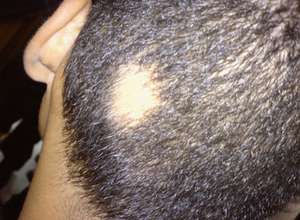Article
Anxiety, Depressive Disorder Prevalence Greater Among Alopecia Areata Patients
Author(s):
In this recent study, mental health conditions associated with alopecia areata were assessed by the study’s investigators.

Alopecia areata (AA) patients are more likely to develop anxiety and depressive disorders compared to the general population, according to recent findings.
The meta-analysis was designed to examine the difference between rates of these mental health disorders and the rates in patients with AA.
The investigators noted that both depressive and anxiety symptoms may technically be identified through questionnaires, but they often relate to somatic symptoms that could be due to the dermatological disease and lead to an overestimation of psychiatric prevalence.
The research team was led by Sophie Lauron, MD, from the Adult Psychiatry and Medical Psychology Department of the Pascal Institut, Clermont Auvergne University in France.
“The aim of this systematic review and meta-analysis was to obtain a more accurate assessment of the different factors associated with prevalence, which to our knowledge has not been attempted before,” Lauron and colleagues wrote.
Background
The team’s meta-analysis gathered studies with data on depressive and anxiety disorders, as well as symptoms, from the following databases:
- PubMed
- ScienceDirect
- the Cochrane Library
- Embase
- PsycINFO
The investigators used the reporting guidelines from the Meta-analysis of Observational Studies in Epidemiology (MOOSE), collecting every study—observational or interventional—with data on disorder or symptom prevalence.
There were also no restrictions laid out concerning either language or patient age for the studies included.
The team assessed the overall pooled prevalence of both conditions through the use of a random effects model analysis, with between- and within-study variability being considered.
They also used meta-regressions as a means to examine the connection between study characteristics and prevalence variations for the conditions.
Findings
The investigators concluded in their meta-analysis of 37 articles—26 regarding anxiety and 29 regarding depression—7% to 17% of AA patients assessed with AA reported either depressive or anxiety disorders needing psychiatric care.
Prevalence of the 2 disorders in the analysis of AA patients—9% for depressive disorders and 13% for unspecified anxiety disorders—was found to be higher than the general population thanks to the team’s distinction between disorders and symptoms being drawn.
The investigators also added that the odds ratio (OR) and prevalence of anxiety and depressive disorders were both found to be notably higher than of anxiety and depressive symptoms (prevalence being 34% and 37%, respectively).
“In this systematic review and meta-analysis, the separate analyses showed that 7% to 17% of patients with AA had depressive or anxiety disorders that require psychiatric care, including specific medication,” they wrote. “Additionally, more than one-third of patients had symptoms that are warning signs and that need monitoring because they can develop into disorders.”
The study, “Prevalence and Odds of Depressive and Anxiety Disorders and Symptoms in Children and Adults With Alopecia Areata,” was published online in JAMA Dermatology.



